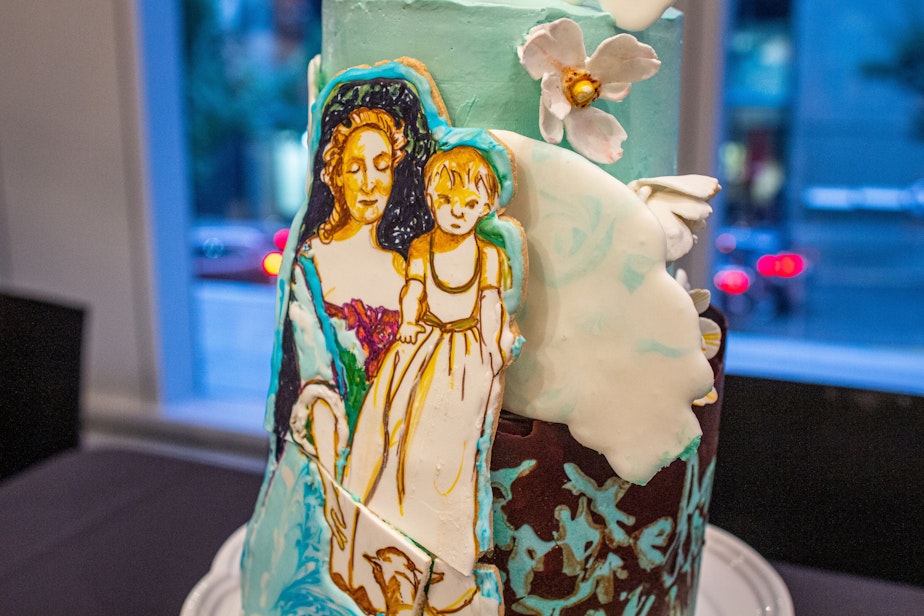Radical bake off: SAM showcases edible pieces of art

You don’t often see a baking competition in a museum. But recently, at the Seattle Art Museum, two dozen professional and home bakers competed in The Great Victorian Radicals Bake Off.
The bakers unveiled sweet creations inspired by artwork from the museum’s Victorian Radicals exhibit.
The main floor of the Seattle Art Museum buzzed with people. They moved from table to table for a glimpse of the entries.
One of the bakers, Karen Okonkwo, stood beside a cake covered in vibrant purple and green fondant. She took her inspiration from a peacock vase by William De Morgan. “So this is an Earl Grey tea cake,” she said. “The buttercream is lemon flavor to match the Earl Grey, and the peacock head is made with rice crispy treats.”
By day, Okonkwo works in medical sales, but off hours she likes to bake and plan events.
Baker Edward Villacorta had his own rendition of the same vase. He made a peacock with sculpted chocolate, its feathers trailing across the cake. “This is a chocolate fudge cake," he said. "And that’s a passion fruit mousse on top.”
Sponsored
The cake took three days to assemble, glaze, and decorate. Villacorta does this sort of thing every day; he’s a pastry chef at the Westin Hotel. But he couldn’t resist an opportunity to test his creativity.
“If I win, it’s the icing on the cake,” said Villacorta. “The fun part was making it.”
The idea for a bake off came from SAM curator Chiyo Ishikawa, who's a fan of the Great British Bake Off.
“In the last stage of the competition for that show they have to make a show-stopper centerpiece," she said. She remembers looking at objects in this exhibition and thinking, "I would like to see somebody make a dessert out of that!”
Ishikawa and two other judges, both professional bakers, chose the winning dessert.
Sponsored
The bake off complements the exhibit in another way. Ishikawa said that Victorian art was created in the midst of the Industrial Revolution. The artists produced paintings, textiles, and furniture as a protest to mass production.
Many artists felt that mass production "represented a kind of dehumanization of the creative process,” she explained. “They were trying to bring back the handmade, the hand dyed, so they loved natural materials. And they felt that if you can work with your hands, the way Medieval craftsmen did, you will live in a better environment and that will consequently make society better.”
Ishikawa sees parallels between the rapid changes of the Victorian era and those of our own. She said it’s one reason they brought the exhibit to Seattle.
“We’ve experienced a digital revolution here," Ishikawa said. "We’ve seen our city change significantly—neighborhoods have changed, new people have moved in, lots of new buildings have gone up, the disparity between rich and poor—these are all parallel situations to what was happening in the 19th century.”
At the same time, there’s an interest among local artists in natural materials, including carefully crafted food.
Sponsored
Which brings us back to the bake off. At the end of the night, more than 200 votes were returned. There were two winners — one chosen by the judges, and the winner of the People's Choice Award.
The People’s Choice Award went to Team Pinoy, a win for Edward Villacorta and his interpretation of the peacock vase.
And the winner of the Great Victorian Radicals Bake Off was . . . Jan Smail of Barn & Field Kitchen and Bakery. Her gluten-free cake was inspired by “The Pretty Baa Lambs,” an oil painting by Ford Madox Brown. She reproduced the main image on a royal icing covered cookie.
Sponsored
“I feel really great,” said a stunned Smail. “At times I had my doubts, though, like oh my god, why did I do this?”
Like many of the contestants, she did it because she was inspired by the artwork—the colors, the light, and the details. Just like the artists from the Victorian era, expressing their creativity with their hands.




